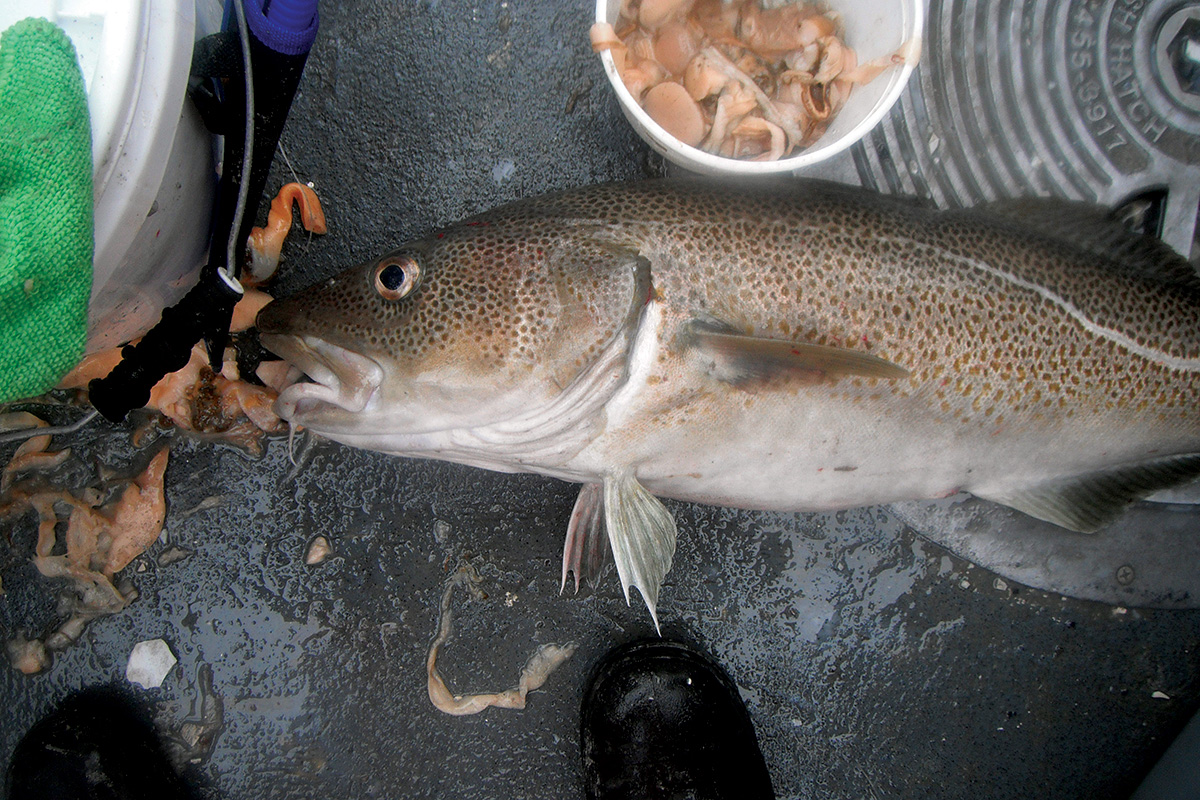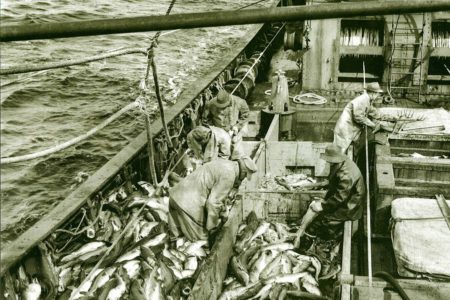
Have you ever stopped to consider why certain anglers along the rails of a winter cod boat are able to put together a vastly better catch than many of the other fares? Sometimes the gap in success rate is quite dramatic as sharpies piece together limits even on days in which their fellow anglers would consider the fishing to be rather tough. The difference often lies in the subtleties of what rig is being employed. There are certainly days that cod will fall to any off-the-shelf rig; however when conditions demand a different approach, it is important to adapt if you want to put cod on the deck with consistency.
To Jig or Not to Jig?
By far the most common blunder you will witness on a winter cod trip is the failure to know when to jig and when to soak bait. Some of the guess work will be taken out of the equation by the captain in his choice to either drift an area of open bottom or set the anchor on a specific piece of structure. This decision can be driven by the conditions or the density of the crowd along the rail. On many of the Southern New England cod grounds such as Coxes Ledge, typically the early portion of the winter season lends itself to better jig fishing. As the main body of cod makes its westward migration from George’s Bank, they often encounter abundant bait lingering on the grounds during December and early January. The presence of herring, mackerel, sand eels or squid, combined with a moderate drift speed, can provide for excellent action on the iron. If you see other anglers bringing any of the aforementioned bait species to the surface on their rigs, tie on a jig and work it faithfully.
Early winter cod often very aggressively chase prey through the water column, giving those working a jig the distinct advantage when drifting open bottom. Let the fish tell you how they want the jigs worked. On some days the fish want a Norwegian jig swung tight to the bottom, while on others squidding a diamond will fill your tote quicker. If the rail is too crowded, or the seas too snotty for safe drifting, the captain will likely decide to simply set-up over a productive piece of bottom. If this is the case, put the jig stick away and prepare to fish some bait.

Soaking Some Snot
As previously mentioned, certain conditions demand that you change your tactics to fishing salted or fresh skimmer clams. While jigging is extremely effective on the drift, it is much less so when fishing on anchor, and it is these cases that one should revert to bait rigs. There will also be times during the winter season where jigs are simply not in the game plan, regardless of how the captain chooses to set the vessel. This is especially true late in the winter season as cod disperse from their previously dense schools and populate broader areas. During late January and on through much of February, the fish are often spread out with smaller clusters of fish being found on the various rock piles and wrecks that dot the grounds from Coxes to Montauk. Whatever the driving factor, it is crucial to choose the correct bait rig for the best possible presentation. Remember that while swinging jigs is an active and often exciting way to catch cod, fishing clams is far and away more versatile in our region.
High-Low, How-To
The good old high-low rig is by far the most commonly employed rig for cod in New England, and for good reason: it works. That said, there is more to this rig than simply affixing two hooks to a standing leader. In general, I prefer to tie bait rigs on 50-pound monofilament, but one can drop down to 40 for very finicky fish or go as high as 60 when dealing with numbers of “steaker” class fish. Hooks should be a high quality 5/0 to 6/0 baitholder or octopus style; however using non-offset hooks, such as the classic 3399 sproat, greatly reduces twist in a hard current.
It is important to consider your specific fishing conditions when you set up your rig on a given outing. In my opinion, the best presentation that you can obtain with a high-low is to run 8- to 10-inch snells off of small dropper loops or Grand Banks knots. This allows for much freer movement of the bait and pushes your offering a bit further from your standing leader. While this is a very nice presentation and will kill totes full of cod, you will find that hard currents have a tendency to spin your baits and turn the snells into a twisted mess. When hard current and fast drift become an issue, ditch the snells and slip your hooks of choice directly onto 4-inch dropper loops. This creates a more compact presentation that twists much less in turbulent conditions.
When drift fishing with the high-low rig, I add some artificial embellishment in the form of 6-inch curly tails in either strawberry, hot pink or green. I generally start the day with only the high hook dressed with a curly tail, and if I find the fish reacting to it with more frequency, I then add one to the lower hook as well. This is a great way to grab a cod’s attention as your rig drifts by, however is does not work as well when sitting on anchor.
The effectiveness of the curly tail is hampered when you do not have a drift to make it move properly. Additionally, when on anchor the fish have much more time to inspect your rig before committing as opposed to the reaction strikes of drift fishing.
It is important to note that you should avoid going overboard in dressing your rigs with too much artificial hardware. I often see folks adorning their rigs with every piece of jewelry possible in the form of various beads, spinners, sliders and skirts. Trust me when I tell you that this is not only unnecessary, but counterproductive. It seems that the “busier” an angler’s rigs are, the lighter their totes tend to be at day’s end.

When to Go Single
The aforementioned variations of high-low rigs will take care of the bulk of your cod fishing, but there will be instances when a single hook rig is advantageous. Late in the winter season there are times when the fishing is truly a grind at best. The fish are spread out and have been beaten up by the fleet for months, prompting many operations to go the extra mile to put some fish on the deck for their patrons. It is during this late-winter period that many boats switch from the cheaper salted clams to fresh-shucked skimmers.
If you venture to the stern of the vessel during the ride to the grounds, you will notice the mates retaining the skimmer shells in totes for chumming later in the day. After locating some fish in an area, often the captain sets the hook and starts chumming by bating clam shells into the water around the boat. There are definitely times when this can turn otherwise negative cod into biters, even if just for brief periods. When fishing a chum bite for finicky cod, I have had the best success with a single hook rig consisting of a slightly longer 12- to 14-inch snell off a dropper loop set about 6 inches from the sinker.
Another situation prompting the use of a single hook rig is in wreck fishing. Anyone who has fished upon the deck of a fall or winter headboat knows the frustration of lost fish and gear to a sticky wreck. This headache can be greatly reduced by running a single hook on a 4-inch dropper hook set roughly “waist high” from your sinker. The advantage of the high-set hook is that your bait sits above the structure of the wreck, making it an easy target for hovering cod. Additionally, the single high set hook means that hooked fish are much less likely to be lost in the structure, as your long sinker line serves as the sacrificial lamb.
Put It to Use
Let’s face it, the winter cod season is too short, and even shorter is the time that most of us get to actually spend on the grounds. Make sure to take carful note of the conditions, baitfish presence and the mood of the fish when you set up your rigs for a day of fishing. Giving some extra attention to the finer points of rigging will greatly increase your chances of full coolers and weary arms.




